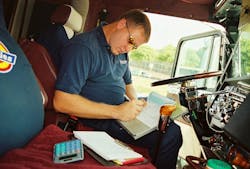A project to show that current CDL drivers in the 18-21 year range can be as safe as their older counterparts may also discover the magic 'it' that makes for the perfect truck driver no matter what their age."By focusing on the younger driver and dialing in on what we think of as the profile of the perfect driver, we may have a tool that all carriers can use to hire new drivers," says John Hausladen, president of the Minnesota Trucking Assn. "Let's say it costs $5,000 or $6,000 for a motor carrier to recruit and bring on a new driver today… I’ve got to believe that given the potential for this [project], it would be a good value proposition."Hausladen says that MTA would like to test the thesis that 18 to 21 year olds can drive as safely as older drivers, and thus no reason to limit them to intrastate driving jobs."We need to gather data that demonstrates that you can safely put younger drivers behind the wheel of commercial motor vehicles," he says. "If you can set up a protocol where you screen, select, train, provide experience and oversight, then you could take a driver younger than 21, give them [permission] to drive farther, drive bigger configurations, and do that in a test environment to validate that it can be done safely."He notes that the association doesn't need any regulatory changes from FMCSA or federal legislation to perform the test because they will keep younger drivers within their state boundaries. The basic idea, says Hausladen, is to use an assessment tool that reflects the most current technology and knowledge."There's been a lot of change in the last 15 years in psychological and behavioral assessment tools. Ideally, you should be able to take a mature CDL holder, let’s say they’re 25 or 30, and map their brain. We're using assessment tools, not putting probes in brains, but using evaluation tools," he emphasizes. "What is about their make-up that makes them a good driver? If you use that template on a driver from age 18 to 20 and screen them against that first, you can eliminate a lot of folks that would never make it. Now you’ve closed the gap in terms of what you’re trying to achieve in that training, oversight and experience."He adds: "The American Transportation Research Institute has agreed to take the lead on this. We came up with the idea; we pitched it to them, and their Research Advisory Council ranked it number four of all of their research ideas. They're beginning the work of evaluating the proper assessment tools." "This project is one of our top priorities," says Rebecca Brewster, ATRI's president and COO. The project was approved by the board in April. "We are in the first stages of developing an initial methodology to identify a younger driver assessment tool. We want to make sure we can develop a screening tool that identifies those younger drivers who possess the cognitive decision-making attributes of older safe drivers. The first question is: what is the profile of a safe 35-year-old driver? Then we will ask: can you find that same profile among the population of younger drivers? Once identified, these people would then put through a pilot test, but we wouldn't move forward with the pilot test until we're sure we have a validated tool."Brewster adds: "It's a bit of a challenge, but assessment tools are out there, and we're trying to find if there's one that currently works for identifying safe driving behaviors for an older population and apply it to the younger."She echoes Hausladen's assertion that an assessment tool discovered during this project could be applied to all potential drivers no matter what their age. "If we find that assessment tool that says 'these are the common attributes of mature safe drivers,' there's no reason we couldn't apply that same assessment tool, not just to younger individuals for purposes of finding those to go through the pilot test, but to use it as a hiring and screening tool going forward for all drivers."How confident is Brewster that such an assessment tool can be found?"I don't know that yet. We have said that we won't move forward with the pilot test unless we can find or develop that tool in a reasonable amount of time."
About the Author

Larry Kahaner
Larry Kahaner is an author, journalist, and former FleetOwner contributor.
Sign up for our eNewsletters
Get the latest news and updates
